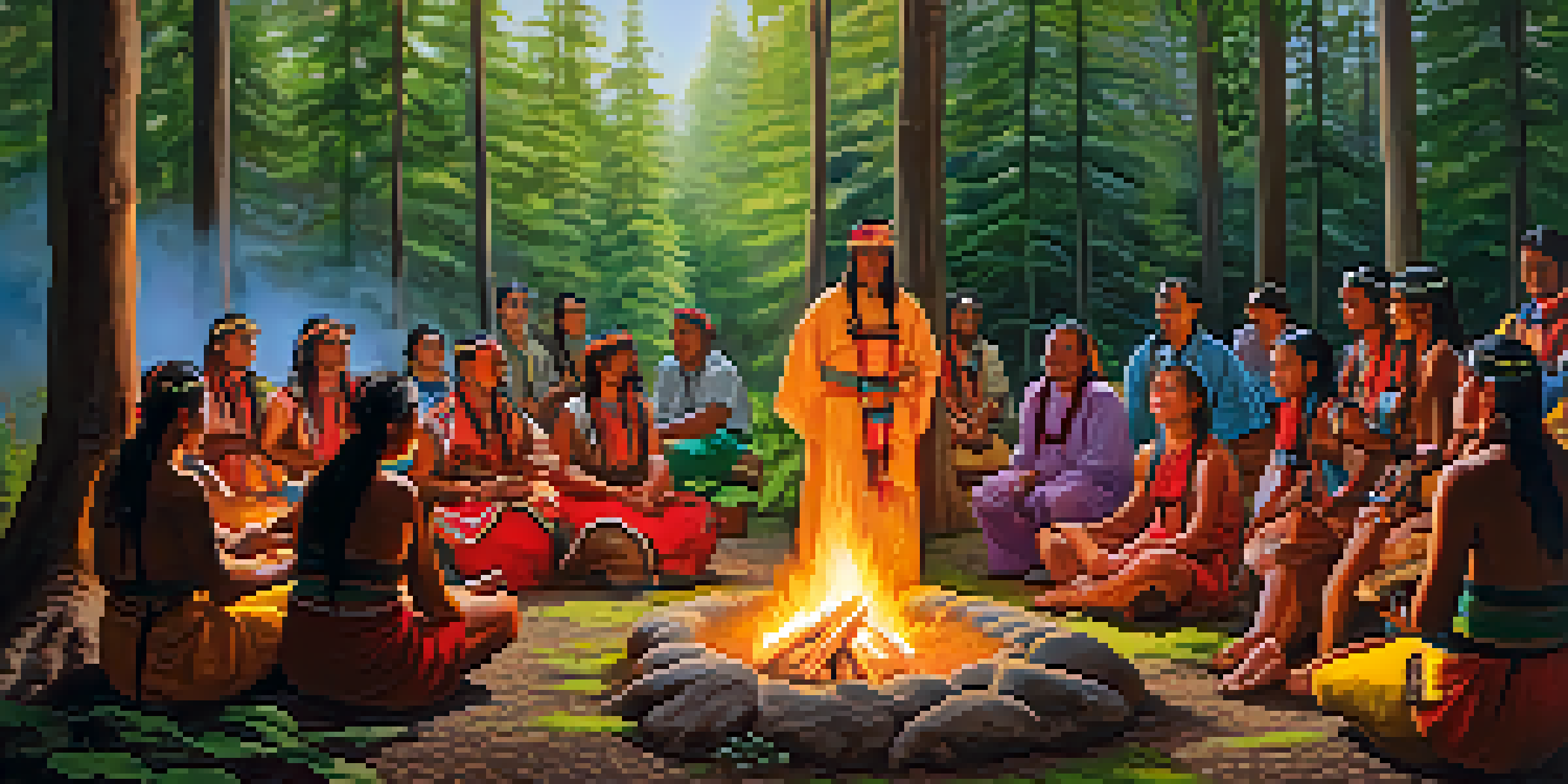Cultural Appropriation vs. Cultural Exchange in Entheogen Use

Understanding Cultural Appropriation and Exchange
Cultural appropriation and cultural exchange are terms often used interchangeably, but they convey vastly different meanings. At its core, cultural appropriation refers to the adoption of elements from one culture by another, typically without permission or understanding. In contrast, cultural exchange involves a mutual sharing where both cultures benefit and appreciate each other's practices.
Cultural appropriation is the act of taking or borrowing aspects of one culture by members of another culture, often without permission or understanding.
For instance, think of cultural appropriation like borrowing a book without asking, while cultural exchange is akin to lending books back and forth, enriching both parties. This distinction is crucial, especially in the context of entheogen use, where substances like psilocybin mushrooms or ayahuasca are deeply rooted in cultural and spiritual significance. Understanding these differences sets the foundation for a more respectful dialogue about indigenous practices and beliefs.
As we delve deeper into the topic, it’s essential to recognize how the context in which these practices are shared influences our perception. By acknowledging the history behind these substances, we can foster an environment that promotes respect and understanding rather than exploitation.
The Role of Entheogens in Indigenous Cultures
For many indigenous cultures, entheogens play a vital role in spiritual and communal practices. These substances are often seen as sacred tools for connecting with the divine, ancestors, or the natural world. For example, the use of peyote in Native American Church ceremonies symbolizes a profound spiritual journey, highlighting the importance of these practices in maintaining cultural identity and community bonds.

When individuals from outside these cultures engage with entheogens, it's crucial to understand the weight of their usage. This is not just about the chemical effects but involves years of tradition, rituals, and meanings that may not be immediately apparent. Without recognizing this depth, one risks reducing a sacred practice to mere experimentation, which can be perceived as disrespectful.
Cultural Appropriation vs. Exchange
Cultural appropriation involves taking elements from one culture without permission, while cultural exchange promotes mutual respect and understanding.
Moreover, the commercialization of these substances can lead to further appropriation, stripping away their cultural significance. By acknowledging and respecting the origins of these practices, we can honor the values they represent and ensure that their use is rooted in understanding rather than exploitation.
Cultural Exchange: Learning from Each Other
Cultural exchange, when approached thoughtfully, can lead to rich learning experiences and mutual respect. When individuals from different backgrounds engage with entheogenic practices through respectful dialogue and collaboration, they create opportunities for shared understanding. This can foster a deeper appreciation for the spiritual and cultural contexts that inform these practices.
The challenge is not to appropriate but to create a dialogue that acknowledges the depth and complexity of others' experiences.
For instance, workshops led by indigenous practitioners that invite outsiders to learn about the cultural significance of ayahuasca ceremonies can promote genuine exchange. Participants not only gain insights into the rituals but also contribute to preserving these practices by sharing their stories and experiences in return. This two-way street enriches both cultures and enhances respect for the traditions involved.
However, it’s important to approach these exchanges with humility and a willingness to listen. This can prevent tokenism and ensure that the voices of indigenous communities are prioritized, ultimately leading to a more equitable relationship between cultures.
The Risks of Misunderstanding Entheogens
Misunderstanding the use of entheogens can lead to harmful stereotypes and cultural insensitivity. When people view these substances solely through a recreational lens, it trivializes their significance and the struggles of the cultures that have historically used them. This can perpetuate misconceptions and encourage a harmful narrative around indigenous practices.
For example, when celebrities promote the use of ayahuasca for personal growth without addressing its cultural context, it can diminish the gravity of its use in indigenous ceremonies. This not only risks cultural appropriation but also creates a narrative that commodifies sacred practices for personal gain. Such actions can alienate the very communities that have safeguarded these traditions for generations.
Entheogens in Indigenous Practices
Entheogens are sacred tools within many indigenous cultures, crucial for spiritual practices and community identity.
Awareness and education are essential in counteracting these misunderstandings. By understanding the historical context and significance of entheogens, individuals can engage with these substances in a more informed and respectful manner, fostering a more profound connection with the cultures that cherish them.
Navigating the Ethics of Entheogen Use
Navigating the ethics surrounding entheogen use requires a careful balance of respect, understanding, and responsibility. It's essential for individuals to consider who benefits from their engagement with these substances and how their actions may impact the communities from which they originate. Ethical considerations should guide the decision to partake in these practices.
For instance, participating in journeys led by indigenous practitioners who are compensated fairly ensures that the communities receive recognition and support. This contrasts sharply with situations where entheogens are exploited for profit without regard for their cultural significance. By prioritizing ethical considerations, individuals can help protect the integrity of these practices.
Ultimately, ethical engagement with entheogens should be rooted in a desire to learn and connect rather than to consume. This mindset fosters a more respectful approach and encourages a deeper appreciation for the rich tapestry of traditions and beliefs surrounding these substances.
The Influence of Modern Spirituality on Entheogen Use
Modern spirituality has increasingly embraced entheogens, often blending various cultural practices into personal rituals. While this can lead to new forms of spiritual expression, it also raises questions about authenticity and respect for the traditions being borrowed from. The challenge lies in discerning when this blending becomes appropriation rather than genuine exchange.
For example, mindfulness retreats that incorporate ayahuasca ceremonies may be well-intentioned but can risk oversimplifying complex cultural practices. When the focus shifts solely to personal enlightenment, the original cultural meanings may get lost in the process. This is where understanding and respect for the origins of these practices become critical.
Ethics of Engaging with Entheogens
Ethical engagement with entheogens requires respect for their cultural significance and considerations for the communities that hold these practices.
It's essential for modern spiritual seekers to approach entheogen use with a sense of responsibility. Engaging with these substances should involve a commitment to honoring their roots rather than merely using them as tools for self-exploration. This respectful approach can bridge the gap between modern and traditional practices, resulting in a more holistic spiritual journey.
Moving Toward Respectful Engagement and Dialogue
As we navigate the complexities of cultural appropriation and exchange in entheogen use, fostering respectful engagement is key. Open dialogues that prioritize the voices of indigenous communities can help bridge gaps in understanding and promote mutual respect. This approach encourages a balanced exchange of ideas and practices, ensuring that all parties feel valued.
Creating spaces where individuals can learn from each other while honoring cultural significance is essential. Workshops, discussions, and collaborative ceremonies can serve as platforms for sharing knowledge and experiences, helping to dismantle stereotypes and misconceptions. This kind of engagement reinforces the idea that cultural practices thrive on shared understanding and respect.

Ultimately, by committing to respectful engagement, we can honor the rich traditions surrounding entheogen use and promote a more inclusive environment for all. This dialogue not only enriches our understanding of these profound practices but also nurtures a greater appreciation for the diversity of human experience.